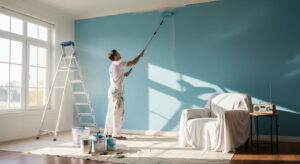Revamping your home’s interior with a fresh coat of paint is an exciting yet daunting task. Choosing the right color scheme requires patience, creativity, and a willingness to experiment. Your home’s color palette should not only reflect your personality but also transform it into a sanctuary that resonates with comfort and style. Here, we delve into key considerations and tips for selecting the ideal interior color schemes to breathe new life into your living space.
Understanding Interior color Dynamics
Understanding Interior color Dynamics: In this section, we delve into the intricate world of interior color dynamics. From the psychological impact of hues to their harmonious combinations, explore how colors transform spaces, evoke emotions, and reflect personal style. Gain insights into choosing the perfect palette for every room.

Harmonizing colors
Incorporating a mix of complementary hues goes beyond mere aesthetics; it adds depth and visual interest to your living space. By blending colors strategically, you create a dynamic environment that engages the senses and creates a welcoming atmosphere. Whether you opt for subtle variations or bold contrasts, harmonizing colors can transform a room from ordinary to extraordinary, making it a reflection of your unique style and personality.
Accentuating Perimeters
Defining the perimeters of each room with different colors is more than a decorative choice; it’s a design strategy that enhances both the visual appeal and functionality of your home. By delineating spaces with distinct colors, you create a sense of organization and cohesion, guiding the eye seamlessly from one area to another. This technique not only adds personality to your home but also contributes to a harmonious flow that makes every room feel connected yet distinct.
Enhancing Architectural Features
Highlighting architectural elements with contrasting paint colors adds depth, dimension, and character to your home’s interior. Whether it’s accentuating the graceful curve of an arch, the intricate details of mouldings, or the cozy alcove of a window seat, using different shades and finishes draws attention to these unique features, elevating the overall aesthetic appeal of your space. Experimenting with paint can transform ordinary architectural elements into captivating focal points that tell a story and breathe life into your home.
Elevating Dull Spaces
Revamping lackluster areas requires a creative approach that combines color, texture, and arrangement. Introducing colorful accents or rearranging furniture can instantly breathe new life into a room, turning it from drab to fab. By incorporating a harmonious blend of colors in furnishings, drapery, rugs, and bedding, you infuse energy and vitality into the space, creating a dynamic ambiance that invigorates the senses. With careful attention to detail and a willingness to experiment, even the dullest of spaces can be transformed into vibrant hubs of style and comfort.
Exploring Different color Schemes
Embark on a journey through the diverse realm of color schemes, where creativity meets functionality. Discover the principles behind monochromatic, analogous, complementary, and triadic schemes, and unravel their unique effects on interior design. From serene neutrals to bold contrasts, uncover the art of harmonizing colors to enhance any space.
Monochromatic
Simplicity meets sophistication with the monochromatic color scheme, where varying shades of a single color dominate the palette. This approach offers a sense of cohesion and tranquility, making it ideal for creating serene and elegant interiors. By playing with lightness, darkness, and saturation, monochromatic spaces achieve depth and visual interest without overwhelming the senses, resulting in a timeless and understated aesthetic that effortlessly enhances any room’s ambiance.
Analogous
Blending neighbouring colors on the color wheel, the analogous scheme creates a harmonious and balanced look that exudes warmth and cohesion. By selecting hues that share similar undertones, such as blues and greens or yellows and oranges, this color scheme evokes a sense of natural beauty and tranquility. Analogous colors work together seamlessly, creating a comfortable and inviting atmosphere that’s perfect for fostering relaxation and connection within your home.
Complementary
For those craving boldness and vibrancy, the complementary color scheme offers the perfect solution. By pairing colors opposite each other on the color wheel, such as blue and orange or purple and yellow, this scheme creates dynamic contrast and visual excitement. The juxtaposition of complementary colors heightens each hue’s intensity, resulting in a lively and energetic ambiance that commands attention. Whether used sparingly or throughout a space, complementary colors inject personality and drama into any interior design scheme.
Triadic
Achieving balance and visual interest is effortless with the triadic color scheme, which involves selecting three colors evenly spaced on the color wheel. By combining hues from different sections of the wheel, such as red, yellow, and blue, this scheme offers a diverse yet harmonious palette that’s both lively and well-balanced. Triadic color combinations infuse spaces with a sense of playfulness and creativity while maintaining a cohesive overall look. Whether used boldly or subtly, triadic colors add depth and personality to any room, making them a versatile choice for interior design.
Practical Tips for Choosing colors
Navigating the vast spectrum of colors can be daunting, but fear not. In this section, we provide actionable guidance to simplify your color selection process. Learn how to consider lighting, space size, mood, and personal preferences effectively. Master the art of choosing colors with confidence and finesse.
Testing Paint Samples in Different Lighting Conditions
To accurately assess how a color will appear in your space, sample it under various lighting conditions. Natural light, artificial light, and evening illumination can all influence color perception. By observing samples throughout the day, you can ensure your chosen hues maintain their desired look regardless of lighting changes, preventing any unpleasant surprises once applied.
Considering The Undertones of Each color To Ensure Compatibility
Every color has underlying tones that affect its appearance. Whether warm, cool, or neutral, understanding these undertones is crucial for creating a cohesive color scheme. By ensuring compatibility between colors’ undertones, you can avoid clashes and achieve a harmonious blend that enhances your space’s aesthetic appeal.
Using Online Tools and Apps For Virtual Visualization
Harness the power of technology by utilizing online tools and apps designed for virtual visualization. These resources allow you to digitally experiment with different color combinations in your room before making final decisions. By virtually testing various hues and schemes, you can gain confidence in your choices and make informed decisions about which colors will best suit your space.
Seeking Inspiration From Design Magazines, Websites, and Social Media
Explore a plethora of design inspiration available in magazines, websites, and social media platforms. From interior design magazines to online forums and social media feeds, these sources offer endless ideas for color palettes and combinations. By exposing yourself to diverse styles and trends, you can discover unique color schemes that resonate with your taste, helping you craft a space that reflects your individuality and creativity.

